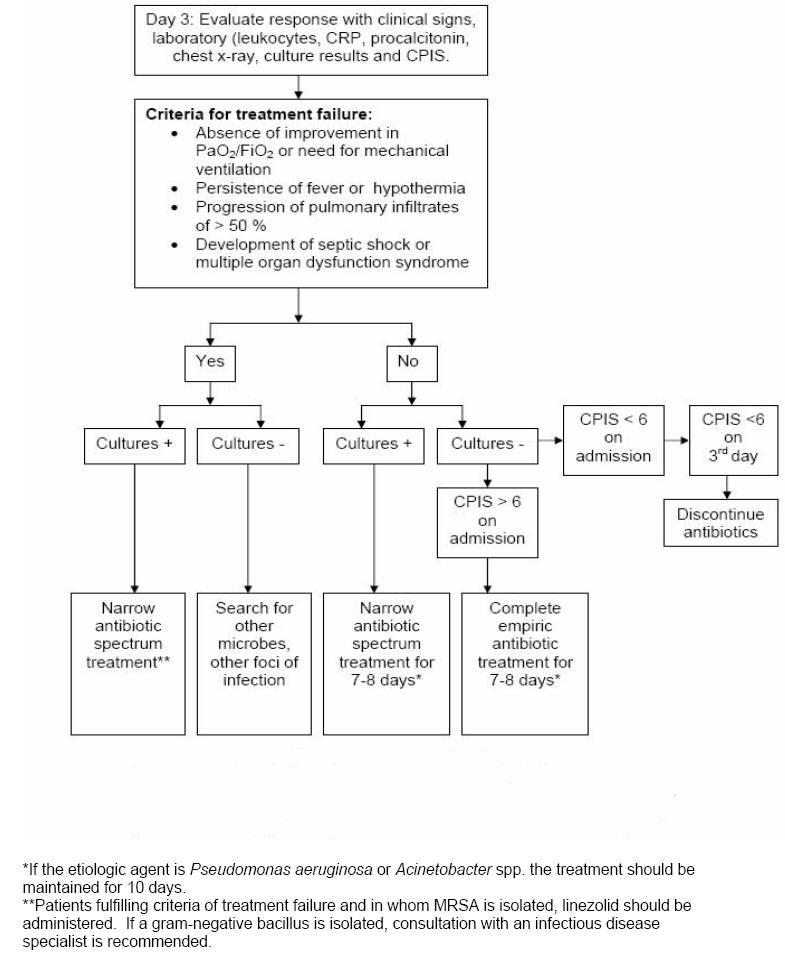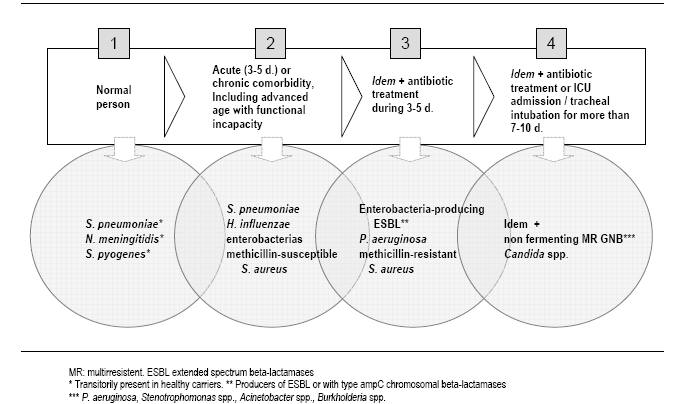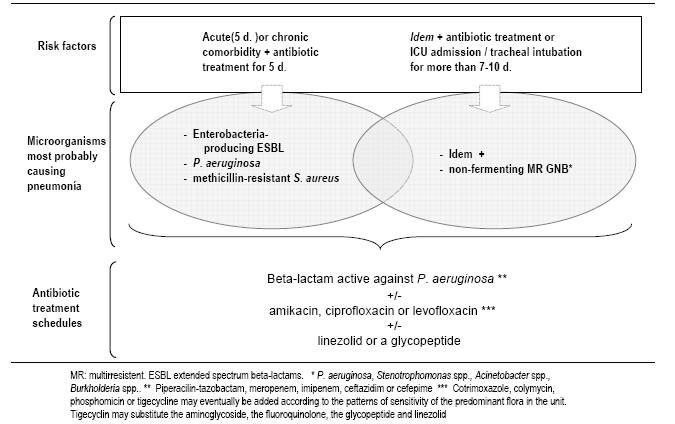 1.
Respiratory Cultures
1.
Respiratory CulturesTable 1. Clinical Pulmonary Infection Score
|
Score |
Day 0 |
|
Day 3 |
Score |
|
|
Temperature, ºC ³38.5º - 38.9º = 1 point ³39.0º - 36.0º = 2 points |
|
Temperature, ºC 38.5º - 38.9º = 1 point 39.0º - 36.0º = 2 points |
|
|
|
Blood leucocytes, mm-3 <4.000 or >11.000 = 1 point 50% band forms = add 1 point |
|
Blood leucocytes, mm-3 <4.000 or >11.000=1 point 50% band forms = add 1 point |
|
|
|
Tracheal secretions Presence of non-purulent tracheal secretions = 1 point Presence of purulent tracheal secretions = 2 points |
|
Tracheal secretions Presence of non-purulent tracheal secretions = 1 point Presence of purulent tracheal secretions = 2 points |
|
|
|
Oxygenation: PaO2/FIO2 >240 or ARDS = 0 point < 240 and no ARDS = 2 points |
|
Oxygenation: PaO2/FIO2 >240 or ARDS = 0 point < 240 and no ARDS = 2 points |
|
|
|
Pulmonary radiography No infiltrate = 0 point Diffuse or patchy infiltrate = 1 point Localized infiltrate= 2 points |
|
Pulmonary radiography No infiltrate = 0 point Diffuse or patchy infiltrate = 1 point Localized infiltrate= 2 points |
|
|
|
Microbiological Data Pathogenic bacterial cultured in rare or hight quantity or no growth = 0 point Pathogenic bacterial cultured in moderate or heavy quantity = 1 point Same pathogenic bacterial seenon Gram stain = add 1 point |
|
Microbiological Data Pathogenic bacterial cultured in rare or hight quantity or no growth = 0 point Pathogenic bacterial cultured in moderate or heavy quantity = 1 point Same pathogenic bacterialseen on Gram stain = add 1point |
|
Total Day #0 = _________ Total Day #3 = _________
Table 2. Differential Diagnosis for Pulmonary Infiltrates in ICU Patients
|
Table 3. Diagnostic Tests in the Workup of Pulmonary Infiltrates in the ICU
 1.
Respiratory Cultures
1.
Respiratory Cultures
Sputum
Endotracheal or Tracheobronchial aspirate** [Toni: should this be transbronchial?]
Bronchoalveolar lavage (BAL) or mini-BAL **
Protected brush specimen (PBS) **
2. Two blood cultures
3. Pleural fluid culture if parapneumonic effusion.
4. Legionella pneumophila urinary antigen and Streptococcus pneumoniae urinary antigen.
5. CBC, electrolytes, hepatic and renal function tests.
6. Arterial blood gases
7. C-reactive protein (CRP) and procalcitonin.
___________________________________________________________
Send samples to microbiology laboratory immediately (or if not possible, refrigerate at 4ºC for a maximum of one hour) Gram staining, intracellular organism counting (only in BAL and mini-BAL) and quantitative cultures *** should be done.
*Collection of cultures should not delay the initiation of empiric treatment in patients with severe sepsis.
**These techniques may be performed by bronchoscopy by blinded procedures.
***Quantitative cultures are performed with the respiratory secretions obtained by transbronchial aspirate, BAL or PBS. The cut-off points for determining infection colonization are: Transbronchial aspirate 105CFU/mL; BAL 104 CFU/mL and PSB 103 CFU/mL.
Table 4. Risk Factors for Infection by Multiresistant Microorganisms
|
Risk factors for Multi-Resistant Microorganisms |
|
Antibiotic treatment within the last 90 days (> 5 days)
Current hospital admission or within the last 90 days (> 5 days)
Immunosuppressive disease and/or treatment
Chronic dialysis within the last 30 days
Epidemic outbreak in the unit by multiresistant organism |
Table 5: Initial Empiric Antibiotic Treatment For Hospital-Acquired Pneumonia or VAP Of Late Onset Or In Patients With Risk Factors For Resistance
|
Microbial Etiology |
Combination antibiotic treatment |
|
Microorganisms from Table 3 plus:
Pseudomonas aeruginosa
Klebsiella pneumoniae (ESBL+)
Serratia marcescens
Acinetobacter spp.
Other nonfermentative GNB
MRSA
Legionella pneumophila
|
Antipseudomonal cephalosporin (ceftazidime or cefepime)* or Carbapenem or Beta-lactam / betalactamase inhibitor + Antipseudomonal quinolone (ciprofloxacin, levofloxacin)** or Aminoglycoside ** (amikacin) ±
Linezolid or vancomycin***
|
GNB = Gram negative bacilli
ESBL = Extended-spectrum beta-lactamase
MRSA = Methicillin-resistant Staphylococcus aureus
*The choice of beta-lactam antibiotic is made as follows: patients who have not received any antipseudomonal beta-lactam antibiotic within the last 30 days are administered piperacillin/tazobactam or antipseudomonal beta-lactam cephalosporin. Patients who have received these prior antipseudomonal drugs are given a carbapenem. Patients with infection by ESBL-producing microorganisms are treated with carbapenem regardless of the results of the antibiogram.
**For combination empiric therapy for multiresistant gram-negative bacilli, an antipseudomonal quinolone is used in cases of renal failure or concomitant use of vancomycin. In other settings combined empiric therapy is initiated with amikacin and is maintained for a 5 day period.
***Empiric therapy aimed at MRSA is initiated in patients with established colonization, previous infection by MRSA, or implementation of mechanical ventilation for more than 6 days. Our antibiotic of choice is vancomycin. However, linezolid is used in patients allergic to vancomycin, creatinine values ≥ 1.6 mg/dL or in patients presenting signs of infection after 48 hours of vancomycin therapy and in those in whom MRSA has been isolated.
Table 6. Initial Empiric Antibiotic Treatment In Hospital-Acquired Pneumonia or VAP of
Early Onset In Patients Without Risk Factors For Resistance
|
Probable Microorganism |
Empiric Antibiotic |
|
Streptococcus pneumonia
Haemophilus influenzae
Enteric Gram-negative bacilli Escherichia coli Klebsiella pneumoniae Enterobacter spp. Proteus spp. |
or
|
Table 7. Antibiotic Dosages and Timing
|
Antibiotic |
Doses |
Interval of administration |
Infusion time |
|
1 g |
12 hours |
1 / 2 - 1 hour† |
|
|
750 mg |
12 hours* |
1 / 2 hour |
|
|
2 g |
8 hours |
2 - 3 hours† |
|
|
2 g |
8 hours |
2 - 3 hours† |
|
|
0.5 g |
6 hours |
1 hour† |
|
|
0.5 – 1 g |
6 hours |
2 - 3 hours† |
|
|
4 / 0.5 g |
6 hours |
2 - 3 hours† |
|
|
400 mg |
8 hours |
1 / 2 hour |
|
|
15 mg / Kg |
24 hours ** |
1 / 2 - 1 hour |
|
|
1 g |
8-12 hours*** |
1- 3 hours* |
|
|
600 mg |
12 hours |
1 hour |
*Administer this dose for 3 days and after continue with 500 mg / 24 hours
**Adjust the dosage according to PK / PD parameters
***Initiate this dose with 24 hours, measure trough blood levels prior to the following dosage and adjust the levels according to values.
†For beta-lactam agents and vancomycin, continuous infusion should be considered.
Figure 1: Clinical Suspicion of Hospital-Acquired Pneumonia

Figure 2: Algorithm for the Management of Patients with Pulmonary Infiltrates

Table 8. Definitions
|
A. SIRS: 2 or more of the following variables: 1. Fever >38◦C or < 36◦C 2. Heart rate >90 beats per minute 3. Respiratory rate >20 breaths per minute or PaCO2 <32 mm Hg 4. Abnormal white blood cell count (>12,000/mm3 or <4,000/ mm3 or >10% bands) B. Bacteremia: bacteria within the blood stream (does not always lead to SIRS or sepsis) C. Sepsis: SIRS plus a documented or presumed infection. D. Severe sepsis: aforementioned sepsis criteria with associated organ dysfunction, hypoperfusion or hypotension. E. Sepsis induced hypotension: presence of a systolic BP <90 mmHg or a reduction of > 40 mmHg from baseline in the absence of other causes of hypotension.” F. Septic shock: Persistent hypotension and perfusion abnormalities despite adequate fluid resuscitation. G. Multiorgan dysfunction syndrome: state of physiological derangements in which organ function is not capable of maintaining homeostasis.
|
Figure 3: Follow up of Patients with Pulmonary Infiltrates

Figure 4: Evolution of the potentially pathogenic microorganisms present in the oropharyngeal flora
related to the comorbidity, antibiotic treatment and colonization pressure.

Figure 5: Empiric antibiotic treatment of VAP in patients without factors of infection by P. aeruginosa

Figure 6: Empiric antibiotic treatment of VAP in setting of risk of infection by P. aeruginosa or
by multiresistant microorganisms
